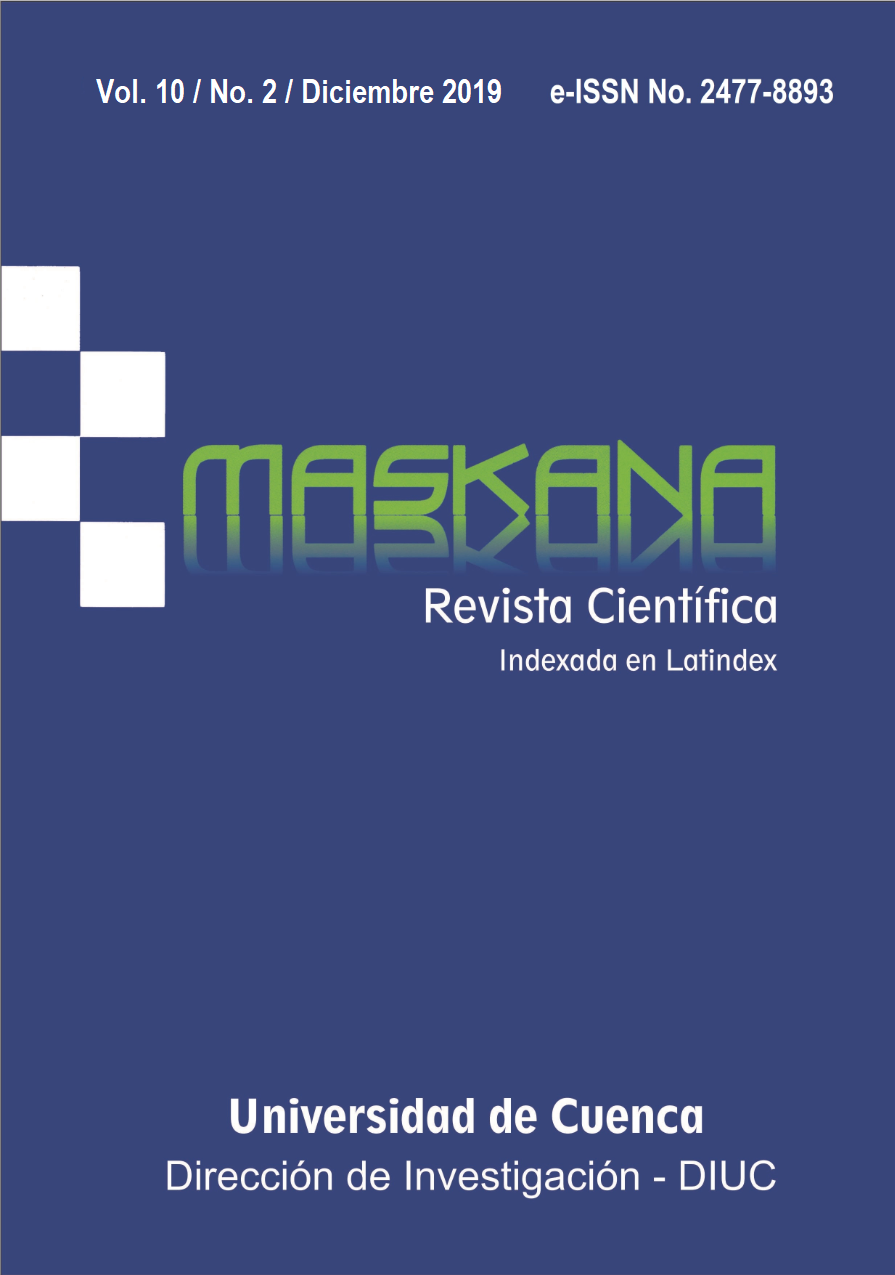Análisis cuantitativo de una mezcla binaria a partir de datos espectrofotométricos UV usando un método alterno
DOI:
https://doi.org/10.18537/10.02.09Palabras clave:
análisis instrumental, análisis de mezclas, espectrofotometría UVResumen
Este trabajo describe un ejercicio de laboratorio útil para un curso de análisis instrumental. En el ejercicio se aplica un método alterno para efectuar el análisis cuantitativo de una mezcla binaria a partir de datos espectrofotométricos UV. Para tal propósito se preparó una mezcla de concentraciones conocidas de ácido 4-aminobenzóico y ácido nicotínico, se registraron sus absorbancias a diferentes longitudes de onda en el intervalo de 242 a 330 nanómetros, y los datos producidos se sometieron al procedimiento alternativo. En éste se realiza una sencilla transformación de la ecuación de absorbancia de la mezcla para obtener una relación lineal a partir de la cual se calcula las concentraciones de sus componentes. Pese a su sencillez, el método produce una muy buena concordancia entre las concentraciones calculadas y las reales de los componentes, errores menores del 2% han sido encontrados. El ejercicio provee una interesante alternativa al procedimiento convencional que habitualmente se enseña en un curso de análisis instrumental.
Descargas
Métricas
Citas
Afkhami, A., & Baharam, M. (2005). Mean centering of ratio spectra as a new spectrophotometric method for the analysis of binary and ternary mixtures. Talanta, 66(3), 712-720.
Attia, K., Nassar, M., El-Zeiny, M., & Serag, A. (2016). Different spectrophotometric methods applied for the analysis of binary mixture of flucloxacillin and amoxicillin: A comparative study. Spectrochimica Acta Part A: Molecular and Biomolecular Spectroscopy, 161, 64-69.
Bashford, C. (1983). Spectrophotometry & Spectrofluorimetry: A Practical Approach. IRL Press Limited, pp. 1-22.
Coello de Escobar, C., & Zimnoch, J. (2014). Effect of the sol-gel route on the textural characteristics of silica imprinted with Rhodamine B. Journal of Separation Science, 37(7), 868-875.
Coello de Escobar, C., Dallegrave, A., Lasarin, M., & Zimnoch, J. (2015). The sol-gel route effect on the preparation of molecularly imprinted silica-based materials for selective and competitive photocatalysis. Colloids and Surfaces A: Physicochemical and Engineering Aspects, 486, 96-105.
Connors, K. A. (1976). Linear graphical kinetic analysis of mixtures. Analytical Chemistry, 48(6), 87-89.
Connors, K. A. (1977). Graphical interpolation method for the kinetic analysis of three-component mixtures. Analytical Chemistry, 49(12), 1650-1655.
Connors, K. A., & Eboka, J. (1979). Alternative graphical methods for the spectrophotometric analysis of mixtures. Analytical Chemistry, 51(8), 1262-1266.
El-Bardiciy, M., Lofty, H., El-Sayed, M., & El-Tarras, M. (2008). Smart stability-indicating spectrophotometric methods for determination of binary mixtures without prior separation. Journal of AOAC International, 91(2), 299-310.
Gazdaru, M., & Iorga, B. (2002). Spectrophotometric analysis of the mixtures of photosynthetic pigments. Journal of Optoelectronics and Advanced Materials, 4(1), 121-129.
Ghasemi, J., & Mandoumi, N. (2008). A new algorithm for the characterization of thermodynamics of monomer-dimer process of dye stuffs by photometric temperature titration. Acta Chimica Slovenia, 55(2), 377-384.
Gonzalez, A., Pablos, F., & Asuero, A. (1991). Spectrophotometric determination of acidic constants of compounds with unsuitable absorption features. International Journal of Pharmaceutics, 72, 193-197.
Hassan, S., & Abdel-Gawad, S. (2018). Application of wavelet and Fourier transforms as powerful alternatives for derivative spectrophotometry in analysis of binary mixtures: A comparative study. Spectrochimica Acta Part A: Molecular and Biomolecular Spectroscopy, 191, 365-371.
Lofty, H., Hegazi, M., Rezk, M., & Omram, Y. (2015). Comparative study of novel versus conventional two-wavelenght spectrophotometric methods for analysis of spectrally overlapping binary mixtures. Spectrochimica Acta Part A: Molecular and Biomolecular Spectroscopy, 148, 328-337.
Naud, D. L. (1996). Thermal descomposition of arylnitramines. Journal of the Chemical Society, Perkin Transactions 2.0, 1321-1324.
Parmar, A., & Sharma, S. (2016). Derivative UV-vis absorption spectra as an invigorated spectrophotometric method for spectral resolution and quantitative analysis: Theoretical aspects and analytical application: A review. TrAC Trends in Analytical Chemistry, 77, 44-53.
Perkampus, H-H. (1992). UV-VIS Spectroscopy and its application. Berlin, Germany: Springer Lab Manuals book series. 244 pp.
Turabik, M. (2008). Adsorption of basic dyes from single and binary component systems onto bentonite: Simultaneous analysis of basic red 43 and basic yellow 28 by first order derivative spectrophotometric analysis method. Journal of Hazardous materials, 158(1), 52-64.
Vijayalakshmi, N., Abdul Feroz, S. K., Naga Masa, Ch., & Jaswanthi, P. (2017). Method development and validation for the estimation of Ofloxacin and Nitaxozanide present in bulk & tablet by simultaneous equation method using UV-spectrophotometry. World Journal of Pharmacy and Pharmaceutical Sciences, 6(6), 1204-1211.
Publicado
Cómo citar
Número
Sección
Licencia
Copyright © Autors. Creative Commons Attribution 4.0 License para cualquier artículo enviado a partir del 6 de junio de 2017. Para los manuscritos presentados anteriormente, se utilizó la licencia CC BY 3.0.
![]()
Usted es libre de:
 |
Compartir — compartir y redistribuir el material publicado en cualquier medio o formato. |
 |
Adaptar — combinar, transformar y construir sobre el material para cualquier propósito, incluso comercialmente. |
Bajo las siguientes condiciones:
 |
Atribución — Debe otorgar el crédito correspondiente, proporcionar un enlace a la licencia e indicar si se realizaron cambios. Puede hacerlo de cualquier manera razonable, pero de ninguna manera que sugiera que el licenciador lo respalda a usted o a su uso. |
| Sin restricciones adicionales: no puede aplicar términos legales o medidas tecnológicas que restrinjan legalmente a otros a hacer cualquier cosa que permita la licencia. |
Mayor información sobre este acuerdo de autoría y licencia, transferencia de derechos o solicitudes de reproducción, pueden ser consultados en este enlace.






